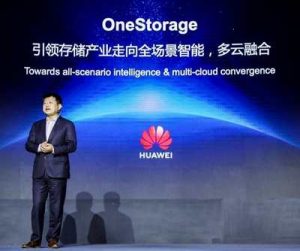MWC Shanghai: Huawei Unveils OneStorage Solution for Telcos
Provides converged storage resource pool for various services and data management that is automated.
This is a Press Release edited by StorageNewsletter.com on March 19, 2021 at 2:33 pmAt MWC Shanghai 2021, Huawei Technologies Co., Ltd. launched the OneStorage solution to help telcos build a future-oriented target storage network that supports diversified service innovation.
Dr. Peter Zhou, president, IT product line, launches Telco OneStorage solution
The solution provides a converged storage resource pool for various services and data management that is automated. It also uses an open architecture to tear down the silos in today’s multi-cloud era, thus helping telcos transform and innovate efficiently.
With the advent of the digital economy, data has become a new production factor. Accelerated digital transformation of telcos leads to data surges. According to estimates, the billing data volume of telcos’ BSS domains will increase by 7.5x, the operation data volume of their OSS domains will grow by 8x, the HD video data volume of their To-C services will climb by more than 10x, and their big data analytics volume will go up by 5x. In comparison, their IT investment is estimated to grow only by about 20%. A storage solution is therefore required to resolve the difference between surging data volumes and comparatively small IT investment.
Dr. Peter Zhou pointed out three storage challenges facing telco transformation:
-
Low resource utilization due to resource silos. Currently, only less than 40% of storage resources are efficiently used in telcos’ data centers. Poor data mobility between storage systems is complicating data value exploitation.
-
Inefficient management. Complex O&M operations require a lot of time and manpower and have poor fault tolerance. It often takes hours to locate one fault.
-
Complex cloud convergence because of cloud silos. Clouds failing to share resources is making cloud evolution difficult for telcos.
The company‘s next-gen OneStorage solution helps telcos tackle the challenges by providing the following capabilities:
One pool for storage on demand
Different storage arrays, including all-flash, hybrid-flash, high-density, and Blu-ray arrays, are integrated into a unified storage resource pool. To meet telcos’ requirements for different application scenarios, especially sprouting digital applications, converged storage resource pools precisely match service SLAs with storage service levels and, on this basis, implement on-demand storage resource provisioning to improve storage resource utilization and reduce CAPEX by more than 30%.
The solution, as Peter put it, provides “reliable infrastructure that fulfills various service SLAs based on Huawei’s unified OceanStor OS and diversified storage hardware.“
One engine for intelligent data management
Storage cost of data differs depending on its storage media. The company uses the Data Management Engine (DME) to automatically sense data temperature changes and allow data to move automatically between different media without applications feeling any difference. As a result, telcos achieve the optimal cost-efficiency throughout data lifecycle.
In addition, the firm’s DME automates storage management and O&M for all scenarios. What is worth mentioning is the company’s DME’s capability in precisely predicting the capacity and performance trends as well as disk faults of storage systems, which turns reactive O&M into proactive O&M. According to estimates, DME can reduce approximately 70% OPEX for telcos.
One framework for multi-cloud convergence
Telcos typically have multiple private clouds in their data center, such as those provided by VMware and Kubernetes. They are seeking to use an open architecture to converge clouds with consistent user experience.
OneStorage solution, in Peter’s words, “allows users to invoke diversified service capabilities with one click” and consequently “enables new applications to roll out quickly and ensures the user experience consistency of cloud services.“
To help telcos build a target storage network based on the OneStorage Solution, the company proposes a 3-step plan to solve problems of upgrading storage media to flash, unifying software for different hardware, changing the storage network to all-IP, pooling storage resources, and provisioning resources as services:
-
Step 1, change the current silo-style construction mode into a pool-style one, and build enterprise storage, block, file, object, and HDFS resource pools to improve resource utilization.
-
Step 2, upgrade storage media to flash. AFAs are proved to save about 40% hardware while accelerating upper-layer services, thus helping telcos save data center room and reduce approximately 42% carbon emission. Replacing the storage network with an all-IP one makes O&M more efficient. Telcos should also tear down the barriers between different storage protocols and build a data lake to consolidate separate resource pools for block, file, object, and HDFS services. In this way, one piece of metadata can be used by different applications to avoid replicating data across resource pools. Service acceleration and data lake deployment will improve data utilization.
-
Step 3, to enable rapid service iteration and innovation, telcos can build all-scenario converged storage resource pools that are oriented to cloud, network, edge, and device and support diversified hardware and multi-protocol interworking. Different types of hardware, such as all-flash, hybrid-flash, high-density, and Blu-ray systems, can be integrated into one software architecture to enable all storage resources to be intelligently provisioned to multi-cloud upper-layer applications according to SLAs. As underlying storage resources are provided automatically on demand, upper-layer services can be more agile, service TTMs can be shorter, and resource provisioning more accurate. In addition, telcos should provide unified automated O&M capabilities, such as service change, monitoring, and resource optimization, at the upper layer to improve data management efficiency.
The 3-step plan enables telcos to evolve toward a future-oriented target storage network smoothly. The company is ready to work with anyone to supercharge digital economy development. It is committed to delivering efficiency, performance, and more agile services and will provide the simplicity to its customers and partners and leave the complex to itself, making it easier for customers to edge closer towards all-scenario intelligence and multi-cloud convergence.
Resource:
MWC Shanghai 2021 website















 Subscribe to our free daily newsletter
Subscribe to our free daily newsletter


